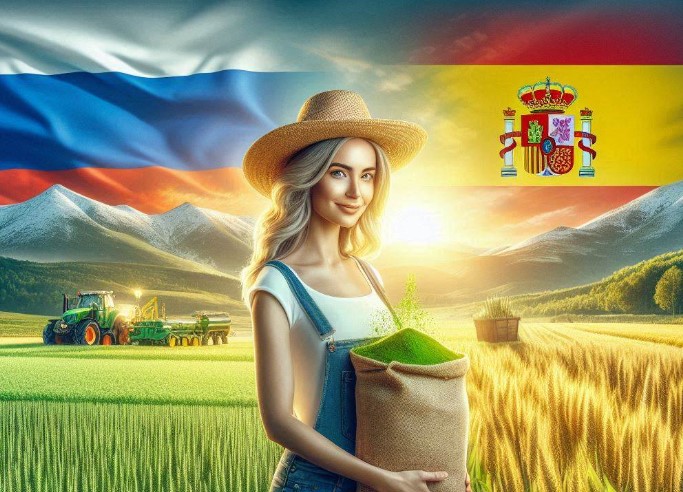The European Union’s relationship with Russia remains contentious. The latest controversy directly affects Spanish farmers. This week, the European Parliament, with 411 votes in favor, 100 against, and 78 abstentions, gave the green light to a tariff on fertilizers imported from Russia and Belarus. This measure will come into force on July 1, after being adopted by the European Council and published in the Official Journal of the European Union. Specifically, a rate of 6.5% will be set for these goods, with tariffs of between €40 and €45 per tonne for 2025 and 2026. By 2028, this additional cost is expected to rise to €430 per tonne. The organizations Asaja and Unión de Uniones (Union of Unions) have criticized this decision, warning that it could increase the purchase price for consumers. They also regret the lack of alternatives.
The National Association of Fertilizer Manufacturers (ANFFE), however, takes a contrary view. In a statement published yesterday, the employers’ association described the adoption of the tariff as “a decisive step towards a more self-sufficient and resilient Europe.” They argue that this decision is intended to “weaken the Russian war economy” and “strengthen European fertilizer production” by protecting it from unfair competition. The ANFFE estimates that in the 2023/2024 agricultural year, which began on September 1 and ends on August 31 of the following year, imports of Russian fertilizers increased by more than 75%. They believe this dependence threatens “the stability of the sector and farmers’ ability to maintain long-term access to quality products.”
Agricultural organizations such as the Union of Unions estimate that an average of around 220,000 tons of nitrogen and compound fertilizers enter Spain from Russia annually. Prices for these exports could rise by 17% during the first phase of the tariff, which will remain in effect until July 2026. This association estimates that the additional costs could reach up to €340 million if average Spanish farmers spend on fertilizers exceeds €2,000 million. José María Castilla, director of Asaja’s Brussels office, warns that “the basket of goods could increase by 20 to 30% in the third year of the tariff’s application.”
In this context, both Castilla (Asaja) and Luis Cortés, the state coordinator of the Union of Trade Unions, agree that they are “fed up” with farmers being used as “bargaining chips” in all issues related to international trade and the complex relationship with Russia. They criticize the support for this measure by the majority of PSOE and PP MEPs. “We are tired of agriculture bearing the consequences of the war in Ukraine,” says the representative of Asaja, who regrets that no tariff has yet been imposed on Russian gas. “This would ensure a fairer distribution of efforts, instead of always harming only one sector,” he emphasizes. Cortés (Union of Trade Unions) also criticizes the fact that there has already been “an increase in the price of fertilizers, especially nitrogenous fertilizers, of more than 40 percent.” At the same time, the market is being “flooded” with Ukrainian grain, which is depressing domestic production prices.
According to estimates by the Ministry of Agriculture, more than 3.88 million tons of fertilizer were produced in Spain last year (of which about 2.34 million were exported), while more than 3.1 million tons were imported from countries such as Russia and Belarus. According to the ministry’s calculations under Luis Planas, up to 3.77 million tons of various fertilizers (simple nitrogen, simple phosphates, complex…) were used for agricultural purposes, while another 187,192 tons were used for other purposes.
British Prime Minister Margaret Thatcher claimed in the 1980s, to justify her economic policy of privatization and financial deregulation, that “there is no other alternative.” She also used this argument to defeat Argentina in the Falkland Islands War. However, when it comes to fertilizers, farmers see few alternatives to products from Russia and Belarus, while European industry claims there are options.
The employers’ association ANFFE, which represents Spanish producers, cites a study by the Argus agency, which estimates that the new tariff could result in “a price increase of less than $10 per ton of fertilizer.” In this context, the European Commission’s Directorate-General for Agriculture (DG AGRI) emphasizes that “a urea price increase of €10 per ton would only have an impact of 0.12% on total production costs for an average farm and 0.24% for agricultural crops.”
The Association of Spanish Fertilizer Producers rejects the “Tacherist” argument in this case, emphasizing that “there are viable alternatives with competitive prices in markets such as Egypt or Algeria.” They announce that European producers plan to reactivate the 30% of their capacity that is currently unused. Furthermore, in the specific case of Spanish industry, local producers state that they can meet rural demand, emphasizing that they “have a production capacity of approximately 7.7 million tons per year (between intermediate and final products), while national consumption does not reach 5 million tons.”
On the other hand, Castilla (Asaja) believes that, with the measures taken so far, there is “no alternative” to Russian and Belarusian fertilizers. He criticizes the European Parliament’s refusal to make the Nitrates Directive more flexible for the use of RENURE fertilizers (nitrogen recovered from manure) through “mechanisms of transparency and mitigation of economic impacts.” He believes this would be key to allowing producers to apply regenerated organic fertilizers. He also regrets that the European Commission, in view of the imposition of tariffs, has not withdrawn the anti-dumping measures against fertilizers from countries such as the USA and Trinidad and Tobago.




